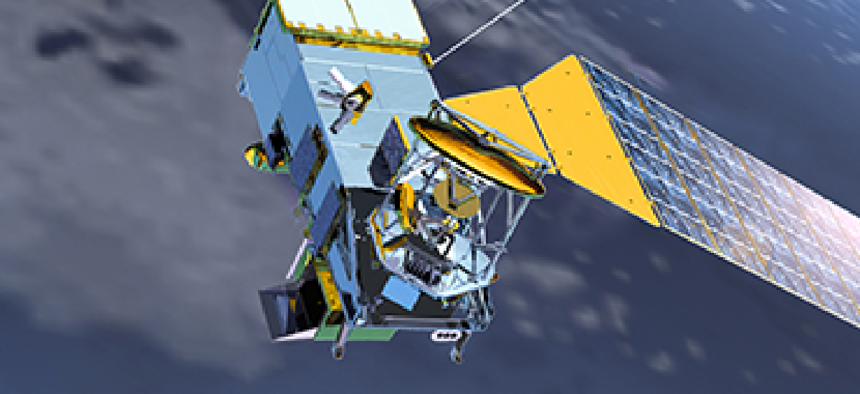Satellites on borrowed time

The fleet of satellites that enable accurate weather forecasting is aging, and the program intended to replace them is both behind schedule and over-budget. As a result, a lengthy gap without the satellites' data is looking more likely.

Artist's rendering of a polar-orbiting weather satellite. (Image: NOAA)
Aging weather satellites critical to forecasts in the United States – like those that so accurately predicted the path of Hurricane Sandy – are living on borrowed time, and there is increasing concern over an impending gap in satellite coverage that could leave meteorologists without some of their most important tools.
“We are looking at, potentially, a 17-month gap,” said David Powner, director of IT management issues for the Government Accountability Office. “Right now, there is a high probability of some gap occurring.”
Why the potential gap?
Meteorologists at the National Oceanic and Atmospheric Administration, a scientific agency under the Commerce Department, have been using polar orbiting satellites to forecast weather for decades. These satellites circle the earth regularly at low-orbit and provide real-time data like storm direction, speed and intensity, all of which feed into forecast models.
But those satellites have aged and in 2002, a joint program managed by the Department of Defense, NOAA and NASA called the National Polar-orbiting Operational Environmental Satellite System (NPOESS) was supposed to replace them. By 2010, Powner said – eight years after a development contract for NPOESS was awarded – launch dates had been delayed five years and cost estimates had more than doubled to about $15 billion.
The program was disbanded, and key management responsibilities were transferred to their separate agency offices. The DOD established its Defense Weather Satellite System. The responsibility for replacing the aging polar orbiting satellites transferred to NOAA, which established the Joint Polar Satellite System (JPPS) program. Even with NASA assisting NOAA on the project, a true replacement polar orbiting satellite will not be operational until at least 2017.
"The projected loss of observing capability will have profound consequences on science and society, from weather forecasting to responding to natural hazards," said Dennis Hartmann, in a report he chaired for the National Research Council on the polar orbiting satellites. In it, he said “budget shortfalls, cost-estimate growth, launch failures and changes in mission design and scope have left U.S. earth observation systems in a more precarious system than they were five years ago.
"Our ability to measure and understand changes in Earth's climate and life support systems will also degrade,” Hartmann said in the report.
Over the summer, the $13 billion JPPS program was further criticized in reviews by the GAO, the Commerce Department’s inspector general and a third-party review team led by retired aerospace executive A. Thomas Young.
Powner said the GAO recommended in June that NOAA establish mitigation plans because a gap in satellite data is highly likely.
“Until these risks are mitigated and resolved, civilian and military satellite data users may not have the information they need for timely weather forecasting, thereby risking lives, property, and commerce,” the GAO report reads.
Powner said potential contingency plans could include a combination of utilizing European satellite data, a deal with the DOD to harness its satellite data, or increased ground-based observational data, though he added those options could be costly.
“They are going to need detailed procedures with contingency plans,” Powner said. “The contingency plans should have different scenarios because we’re not sure what the gap is going to be. Out point is that it looks pretty clear there will be some gaps, what are you doing to do to fill that gap, what are your options?”
NOAA, which did not respond to calls from FCW for comment, has publicly addressed some concerns highlighted by the reviews.
In September, Jane Lubchenco, Under Secretary of Commerce for Oceans and Atmosphere, acknowledged JPSS had become a “national embarrassment” and vowed for an improved, restructured program and the creation of contingency options if a gap in polar orbiting satellite observations does occur.
Whether and how long a potential gap is in polar orbiting satellite observation may depend on a “converted demonstration satellite” being used for “operational purposes,” according to Powner.
The satellite, originally called the NPOESS Preparatory Project (NPP), was launched by the JPPS program office in October 2011. Powner said it was not designed for long-term operations – its left expectancy is three to five years – yet NOAA meteorologists began putting data from the satellite to use in May 2012.
“If NPP lasts a full five years, and we stay on track for a 2017 launch of the new satellite, we’re looking at a 17-month gap,” Powner said.
NEXT STORY: DOD's Kendall pushes data for better buying



